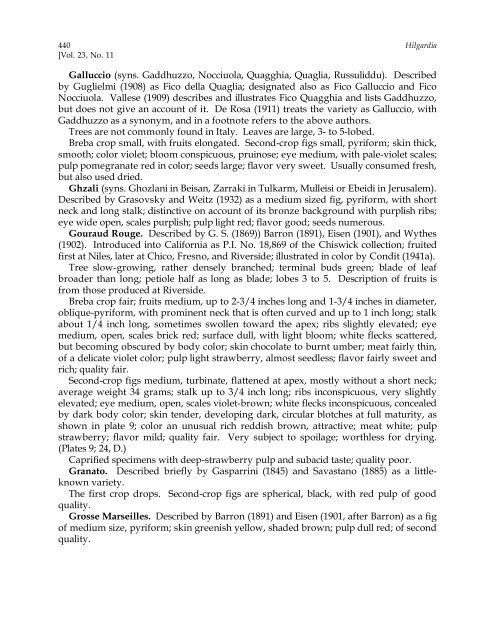Fig Varieties: A Monograph - uri=ucce.ucdavis
Fig Varieties: A Monograph - uri=ucce.ucdavis
Fig Varieties: A Monograph - uri=ucce.ucdavis
Create successful ePaper yourself
Turn your PDF publications into a flip-book with our unique Google optimized e-Paper software.
440 Hilgardia<br />
[Vol. 23, No. 11<br />
Galluccio (syns. Gaddhuzzo, Nocciuola, Quagghia, Quaglia, Russuliddu). Described<br />
by Guglielmi (1908) as Fico della Quaglia; designated also as Fico Galluccio and Fico<br />
Nocciuola. Vallese (1909) describes and illustrates Fico Quagghia and lists Gaddhuzzo,<br />
but does not give an account of it. De Rosa (1911) treats the variety as Galluccio, with<br />
Gaddhuzzo as a synonym, and in a footnote refers to the above authors.<br />
Trees are not commonly found in Italy. Leaves are large, 3- to 5-lobed.<br />
Breba crop small, with fruits elongated. Second-crop figs small, pyriform; skin thick,<br />
smooth; color violet; bloom conspicuous, pruinose; eye medium, with pale-violet scales;<br />
pulp pomegranate red in color; seeds large; flavor very sweet. Usually consumed fresh,<br />
but also used dried.<br />
Ghzali (syns. Ghozlani in Beisan, Zarraki in Tulkarm, Mulleisi or Ebeidi in Jerusalem).<br />
Described by Grasovsky and Weitz (1932) as a medium sized fig, pyriform, with short<br />
neck and long stalk; distinctive on account of its bronze background with purplish ribs;<br />
eye wide open, scales purplish; pulp light red; flavor good; seeds numerous.<br />
Gouraud Rouge. Described by G. S. (1869)) Barron (1891), Eisen (1901), and Wythes<br />
(1902). Introduced into California as P.I. No. 18,869 of the Chiswick collection; fruited<br />
first at Niles, later at Chico, Fresno, and Riverside; illustrated in color by Condit (1941a).<br />
Tree slow-growing, rather densely branched; terminal buds green; blade of leaf<br />
broader than long; petiole half as long as blade; lobes 3 to 5. Description of fruits is<br />
from those produced at Riverside.<br />
Breba crop fair; fruits medium, up to 2-3/4 inches long and 1-3/4 inches in diameter,<br />
oblique-pyriform, with prominent neck that is often curved and up to 1 inch long; stalk<br />
about 1/4 inch long, sometimes swollen toward the apex; ribs slightly elevated; eye<br />
medium, open, scales brick red; surface dull, with light bloom; white flecks scattered,<br />
but becoming obscured by body color; skin chocolate to burnt umber; meat fairly thin,<br />
of a delicate violet color; pulp light strawberry, almost seedless; flavor fairly sweet and<br />
rich; quality fair.<br />
Second-crop figs medium, turbinate, flattened at apex, mostly without a short neck;<br />
average weight 34 grams; stalk up to 3/4 inch long; ribs inconspicuous, very slightly<br />
elevated; eye medium, open, scales violet-brown; white flecks inconspicuous, concealed<br />
by dark body color; skin tender, developing dark, circular blotches at full maturity, as<br />
shown in plate 9; color an unusual rich reddish brown, attractive; meat white; pulp<br />
strawberry; flavor mild; quality fair. Very subject to spoilage; worthless for drying.<br />
(Plates 9; 24, D.)<br />
Caprified specimens with deep-strawberry pulp and subacid taste; quality poor.<br />
Granato. Described briefly by Gasparrini (1845) and Savastano (1885) as a littleknown<br />
variety.<br />
The first crop drops. Second-crop figs are spherical, black, with red pulp of good<br />
quality.<br />
Grosse Marseilles. Described by Barron (1891) and Eisen (1901, after Barron) as a fig<br />
of medium size, pyriform; skin greenish yellow, shaded brown; pulp dull red; of second<br />
quality.
















![Fig Trees in North Carolina [Archive] - IDigMyGarden ... - Figs 4 Fun](https://img.yumpu.com/26905320/1/190x245/fig-trees-in-north-carolina-archive-idigmygarden-figs-4-fun.jpg?quality=85)